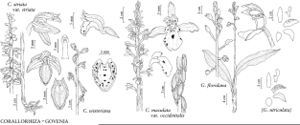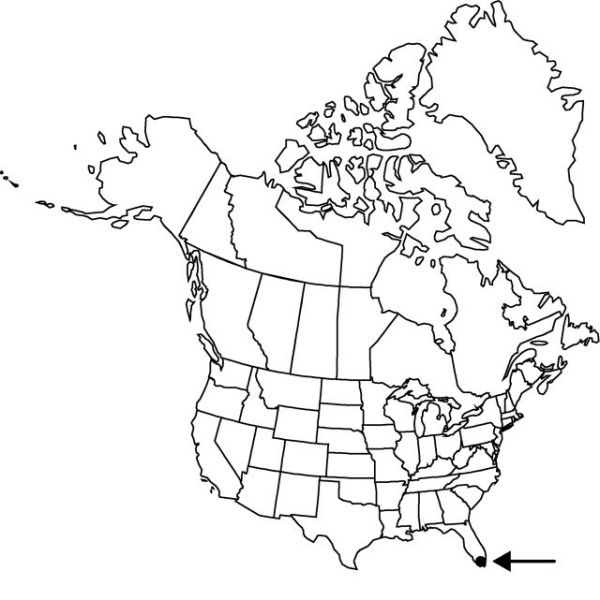Govenia floridana
N. Amer. Native Orchid J. 6: 233, figs. 1, 2, 3 [left], 4. 2000.
Plants to 50 cm. Roots 6–10 × 5–10 cm. Pseudobulbs 3–8 cm. Leaves 2; petioles concentrically arising from terminal nodes of pseudobulb, inside 3 concentric, polygonal, keeled sheaths, 3–30 cm; blade elliptic, 20–35 × 8–11 cm, apex acute. Inflorescences to 50 cm. Flowers opening partially, white; sepals arcuate; dorsal sepal obovate, concave, 19 × 6 mm; lateral sepals falcate, 15 × 5 mm; petals internally purple-flecked, arcuate-concave, oblique, 13 × 7 mm; lip with 3–5 purplish spots on apical margins, nearly elliptic, arcuate, clawed, 16 × 11 mm. Capsules pendent, ellipsoid, 3 × 1 cm.
Phenology: Flowering Nov–Dec.
Habitat: In leaf litter in shade of mixed tropical forest
Elevation: 0–100 m
Discussion
Govenia was discovered in Everglades National Park in 1957 by Frank C. Craighead (C. A. Luer 1972). Intensive searches in 1988 and 1989 failed to find any plants; in 1990 R.P. Sauleda reported it from nearby Osteen Hammock, and in 2000, Paul M. Brown found four small, immature plants at the original site (P. M. Brown 2000d).
The genus Govenia is unusual in that morphology, as seen preserved in pressed specimens, is not always a reliable character for distinguishing species. With this in mind, the Florida plant was compared with known similar species. It was first identified as G. utriculata (Swartz) Lindley (C. A. Luer 1972) but G. floridana differs from that species in that the sheaths are not inflated, it is nearly polygonal in cross section, the column is prominently winged, and the petals are spotted (E. W. Greenwood 1991). The racemes and flowers of the Florida Govenia are similar to those of the eastern Mexican G. alba A. Richard & Galeotti; they differ in the nature of the column foot. The foot of G. floridana is concave and winged and emerges from the column at an oblique angle, whereas the foot of G. alba shows no indication of wings and emerges from the column at a right angle (cf. P. M. Brown 2000d, fig. 2). Brown has taken those differences to indicate that the Florida Govenia is a new species endemic to Florida. For the purposes of this flora we are accepting that decision but recognize that proof of its uniqueness will only come when fresh flowers can be studied and compared with those of other species. The immature plants found in Everglades National Park may one day make this possible.
Selected References
None.

